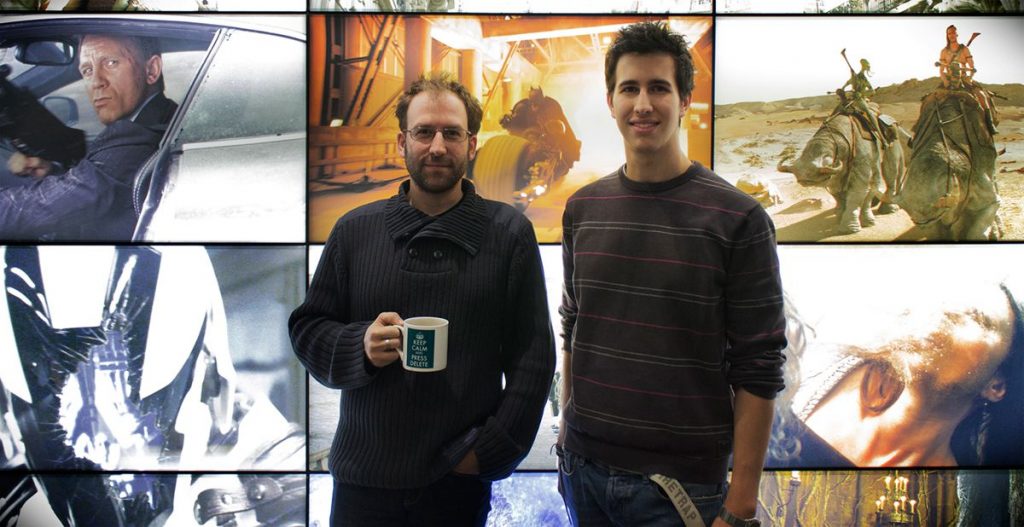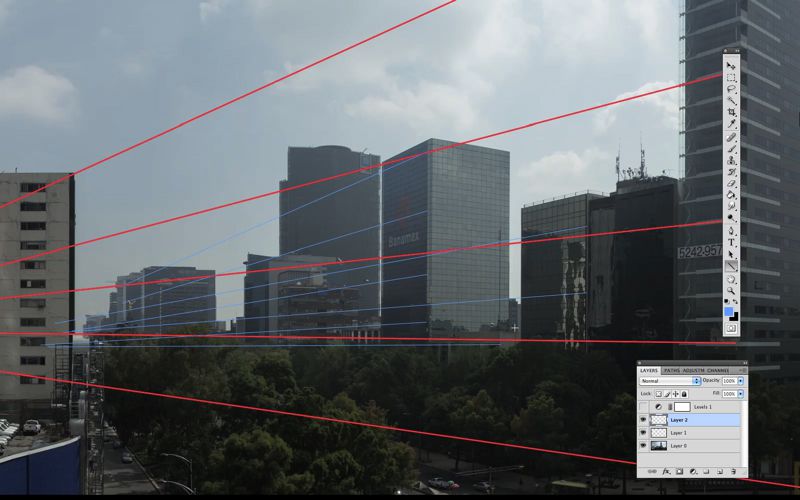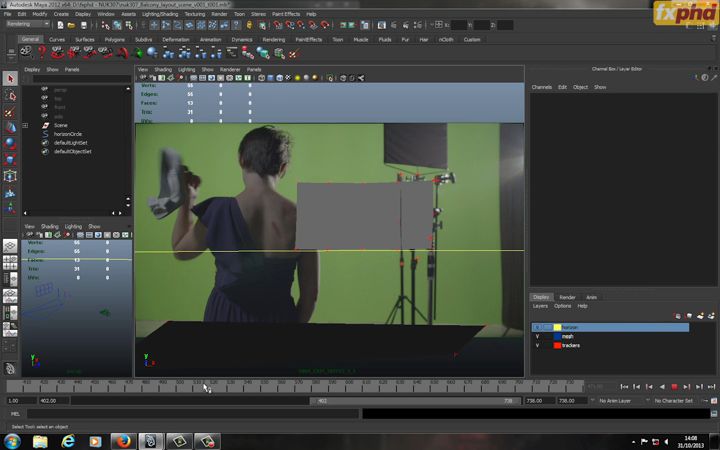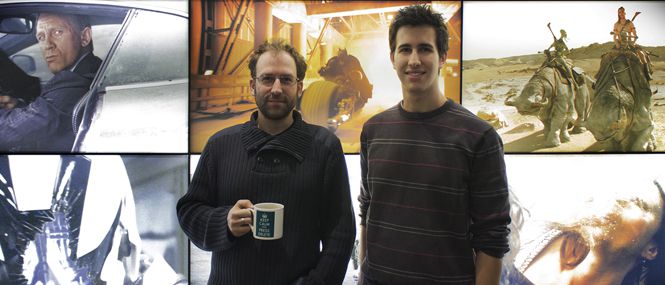Visual effects artists Ludovic Iochem and Nick Marshall, both from Double Negative in London, are teaching NUK307: Advanced Matte Painting this term at fxphd. In the course, participants are working through a main reveal shot from the short film The Last Chick, where a female lead finds herself in a deserted Mexico City. We thought we’d take the time to ask Iochem and Marshall how they came to be at Dneg, as well as their thoughts on the fields of digital matte painter and environment visual effects.
fxphd: How did you guys get started in the VFX industry?
Nick Marshall: Having had a keen interest in traditional arts whilst growing up, I was looking for a way to apply this to some sort of career once I left school. Being a big fan of movies, I chanced upon some ‘making of’ material on some dvds, and was fascinated by the concept design and visual effects. I convinced myself I would never be a good enough artist to be a concept designer, but thought that I would try my hand at animation. All the information I found on animation seemed to suggest that the first step was still to solidify your artistic skills, so it seemed that no matter what, I was going to have to study hard at being an artist. At some point between learning the basics of 3D and improving my artistic skills, I stumbled on some information on matte painting. This seemed like the perfect mix of art and technology (having just made the transition to digital a few years earlier), and so I put all doubts about my artistic skills aside and threw myself into working to become a matte painter. After studying for a degree in Digital Visual Effects, I sent out a matte painting reel to the one studio I really wanted to get in to at the time, Double Negative in London, and a few weeks later I was offered a 2 week temporary position to work as a runner to cover somebody’s sick leave. 5 years later, they are still trying to get rid of me.
Ludovic Iochem: I’ve been very lucky. After having studied sciences and programming at high school, I decided to try to enter into the big French Films schools (Louis Lumiere and FEMIS). But it didn’t work, and I decided to go into a University which proposed a generalist CG training. I didn’t really know what I would do next, but I stayed there for few years, exploring different routes, from Photo manipulation to 3D, and MEL scripting. I’ve directed a lot of short films and have been very interested into the use of the new techniques on stage, and the way to create some emotions through these new techniques.
I started a PHD on this subject, but it didn’t really work, everything was moving really fast, and I couldn’t reduce my subject to something specialized enough to be interesting. One day, I came back home and started to do some matte painting. I was a big fan of this technique because I used to watch the TV Show “Movie Magic” which was presenting a lot of matte painting and glass painting from movies in the 80’s and 90’s. So I decided to train to do some matte painting for my own, thinking that there wasn’t any matte painting work in France anyway. I only knew few big names at this time, like Yannick Dusseault and Dylan Cole. I knew the work of Matte World Digital, and that was it. But when I started to look at the VFX companies, I discovered there were few French matte artists, 3 or 4 around Paris. I contacted one of them, from the studio Mikros Image, and I started to show him my work. I kept working like this, alone, at home, during few months, trying to reproduce some matte painting I found on the internet, and one day, I started at Mikros Image as a matte painter, and that’s how everything started.
fxphd: You’ve both been able to work on several productions and at different studios – what have you found interesting about working on large effects-heavy movies but also more ‘invisible effects’ ones too?
Ludovic Iochem: I started in France, where we don’t have very big projects. VFX is still an area where there is not much money allowed, and you need to be very clever to be able to deliver what the director wants, in time, in the budget. And that’s why I loved working in Paris because you have to know every cheat, all the way to turn around the problems and avoid them. It’s a very good school for VFX artists because you need to be very very creative to be able to achieve the job.
Generally, I prefer the invisible effects. I really enjoyed working on Bourne Ultimatum and Quantum of Solace for this. There are less VFX shots, the team is smaller, but it’s quite challenging to do something in order to people don’t see anything. I like being in a cinema, watching a movie, and think “well, here, everything is just a big DMP, but I’m the only one to know.”
Working on very large show, like Thor, is also very interesting because of the amount of work we need to achieve. The team is huge, deadlines are tight, and the work is very challenging. It’s more about defining the best pipeline depending of the people available, and the time you have. So I would say, you really can find some interest in all the type of project, but it’s good to change. I wouldn’t like to do always the same type of films.
Nick Marshall: A lot of the hype with visual effects work tends to surround the effects heavy blockbusters, but I have always thought that the Holy Grail of vfx is really to nail those invisible effects shots. There tends to be a certain level of stylisation with the big vfx movies that looks very cool and where the ‘larger than life’ appeal is something the studios / directors really push for, but to be able to do a totally photoreal piece of vfx work with all the tiniest imperfections, nuances and attention to detail that make something disappear into the shot is still a real buzz for me. The shots that get me most excited are the vfx heavy shots where the aim isn’t to stand out, but to just be totally convincing.

fxphd: At an overall level, what do you think are some of the most important considerations when approaching a digital matte painting shot?
Nick Marshall: Lighting and composition are still key for me. Even over the last few years I have noticed that every last pixel now has to be perfectly sharp and textured, but it’s wasted effort if the general read in that brief few seconds that it appears on screen is not good. I think the old school traditional matte painters knew that lighting was what matte painting is all about, and that can get lost in amongst all the technical aspects of matte painting today, but for me, this is still probably the single most important thing to get right. Other than that, I think having a broad skillset so that you can tackle any challenge in the most efficient way possible is very important.
Ludovic Iochem: I’d say, you need to focus on what is important. Sometimes, it’s not easy to find out, but it’s the key to sell the shot. Of course, you have to respect the basics, like perspectives, lighting, composition. Everything needs to be perfect at this level, otherwise it won’t work, but most of the time, nobody really knows in advance how the shot needs to look exactly. The brief is pretty vague, and the first version is really important to lock the look and the direction. You need to propose something, which isn’t necessary what you love the most, but which needs to be what you think the client wants. So it’s always good to see the previous shots that has been approved, the concepts, the production references, etc. You need to understand the shot, before you’re start to work on the details.
fxphd: What tools have you been traditionally using in your work – and what are you excited to try out in the near future? What still needs to be worked on, do you think, in terms of tools?
Ludovic Iochem: The main tools in Environment today are Photoshop, Maya and Nuke. We always have to jump from one to another one. Most of the time, I prep my layers in Photoshop, and assemble them in Nuke. On the top of this, now we also need to use MARI, and sometimes we can play with other software like Vue, Mudbox or Painter for very specific tasks. I’ve been testing a few other pieces of software recently which seem to be very interesting like Photoline, which is a 32b float painter, Krita, another painting software, and Clarisse, a stand alone renderer which allows you to actually do pretty much all your shot in a very clever way.
Everything is going very fast lately, especially around the renderer, which is becoming really interactive. In the future, I’d love to get something which allows you to light and render your scene, bring this render into a painting tool, let you work on it as you would do in Photoshop, and let you re-project it with the flexibility and the interactivity of Nuke.
Nick Marshall: I think it is a really exciting time for digital environments at the moment. Traditionally I would be using mostly Photoshop, with Maya for projections, and Nuke has become a key part of that in the last few years as a very quick and easy projection tool. Matte painting is of course becoming more and more of a 3D discipline, and I am quite excited about some of the crossovers between 2D and 3D that will really aid the environment pipeline. More advanced shading, lighting and rendering in Nuke is going to become a big time saver, and other tools like Clarisse look to hold some real promise for handling large scale full environments. I am enjoying the race between renderers at the moment, as this is really shaking things up and pushing a few different solutions to keep innovating, and this sort of competition in the end will benefit the artists. Mari and Speedtree have also become staple tools for the matte painting workflow.

fxphd: Can you discuss some of the shots you worked on for Thor: The Dark World?
Nick Marshall: I was lucky on Thor to come onto the show right at the beginning, where the environments team consisted of just myself and Ludo who was supervising the environments, as we had just finished working together on Les Miserables. This was a great chance for us to develop some new pipeline tools and test some different ways of working, which was a lot of fun and an interesting challenge. Later on in the show once we had the turnover and the environments team had grown (to around 25 people at its peak), I was fortunate enough to work on some nice epic Asgard establishing shots, and provide any matte painting and projections required, plus the occasional leap into full CG. As with any environment that is purely imaginary, we were kept on our toes by the constantly evolving designs and ideas, but having a good team of environment artists, all with different backgrounds (a mix of modellers, lighters, texture artists, matte painters and compositors!) made for a great working environment.
Ludovic Iochem: I haven’t done a lot of shots myself on Thor, as I was leading the team, which was pretty big, but I managed to pick a few at the end. I worked on a night shot flying over Asgard with the Arkship revealing itself. It was a CG render that I turned into night. Then, I’ve added a lot of small lights everywhere. It was a nice shot to do. I also worked on some background mountains during the skiffs chase, and the interior of a mountains, full of statues, that Thor and Loki cross during the chase. For the rest of work, the Env team delivered a huge amount of shots in total, a lot of skies, background mountains, set extension of corridor, city, night and day, some big cyclorama of Asgard, some planets shot from the space, a lot of different type of shots actually. I’m very proud of what we’ve all achieved on this project, it’s been a wonderful experience for me. I learnt a lot as well.
fxphd: When did you first come into contact with fxphd?
Ludovic Iochem: I’ve known fxphd for a long time, because I read fxguide and listen to the podcast. A few months ago, we launched DMPCoach with Nick, a forum board that we use to organize DMP Workshop. One of the members is also a member of fxphd and one day he told us we should contact fxphd. But before we did that, we w’ere contacted by John, who proposed teaching the Advanced Matte Painting course to us. It was a great opportunity for us to keep doing what we like: sharing something we’re really into.
Nick Marshall: I have been a long time listener to the fxguide and vfxshow podcasts, so was always aware of fxphd in my peripheral. I learned more about the courses while working with Tahl Niran a few years ago, but only really discovered the scope extent of the training material that fxphd offers when we began discussing the NUK307 course.

fxphd: What do you hope students can take away from your advanced matte painting course?
Nick Marshall: Hopefully by the end the students will feel comfortable working across different software and learning more about how each step plays into the next. In our experience a lot of people have some proficiency in one area, either painting, 3D or compositing, but are frustrated that they don’t have the skills or knowledge to feel confident handling a full shot from start to finish, so we want to try and offer this, whilst showing methods that will allow the students to start handling shots that can vary from being heavily 2D painting to more 3D full environments.
Ludovic Iochem: Matte painting is not very technical by itself compared to other disciplines, but you can’t be crazy and do whatever you want, as you want, because you need to respect some rules. You don’t want to damage the plate, to clamp the values, you need to be able to go back to the previous stage, all the time until the end, you want to be able to provide all the elements on separate layers, and to integrate yourself in the rest of the all pipeline. That makes it a bit more difficult, because you need to really understand how to do it. Everything is not about doing a nice image. That’s the most visible part, of course, but you need have a good methodology to achieve it, and I’d be plenty satisfied if the students would understand this methodology.
fxphd: Do you spend time on personal projects, both in terms of any digital work or on outside activities?
Ludovic Iochem: I don’t really have the time no. I’d love to do more photography, because that’s something I really like, but when I’m home, I prefer to spend my time with my family, playing with Pirates ship, Dragons, and Knights 🙂
Nick Marshall: If I don’t have a personal project on the go, it’s because I am thinking of what my next project should be! Recently this has involved offering a lot of training, both working with fxphd and on our site dmpcoach.org, which is not something I expected to be doing and has actually helped me to grow as an artist too. I always have a software or skill that I am learning, and at the moment I am working as Beta tester on an upcoming renderer, so I have plenty going on. Plus I am in the process of buying a house, which is a huge project in itself!
fxphd: Any pieces of advice for aspiring matte painters/compositors looking to get started in visual effects?
Nick Marshall: Always study nature. It sounds so simple, but its just so important to getting your shots to feel real, and so many times people forget to pull something up that is real to guide their decisions. Be disciplined, and very focussed as you learn. I think the number one skill might be the ability to self-assess your work. This doesn’t mean hating everything you do, but you have to be able to really clearly see what works and what doesn’t work, and then take that a step further and figure out why some things work and some things don’t. Some people only see the problems in their work and get frustrated, while some people can’t see the problems in their work at all, but you will improve fastest if you can learn from both your successes and your failures.
Ludovic Iochem: Work, try, test, and practice, everything, and always, because the VFX world is going so fast, that you need to be really flexible, polyvalent, in your way of thinking. I don’t think everyone should know how to do a shot from the matchmove to the final comp, but again, to me, it’s crucial to have a very good understanding of every stage of a production. And there is nothing better than trying yourself something to understand where are the issues, and where are the answers.
Find out more about NUK307: Advanced Matte Painting and other fxphd courses at our course overview page.
